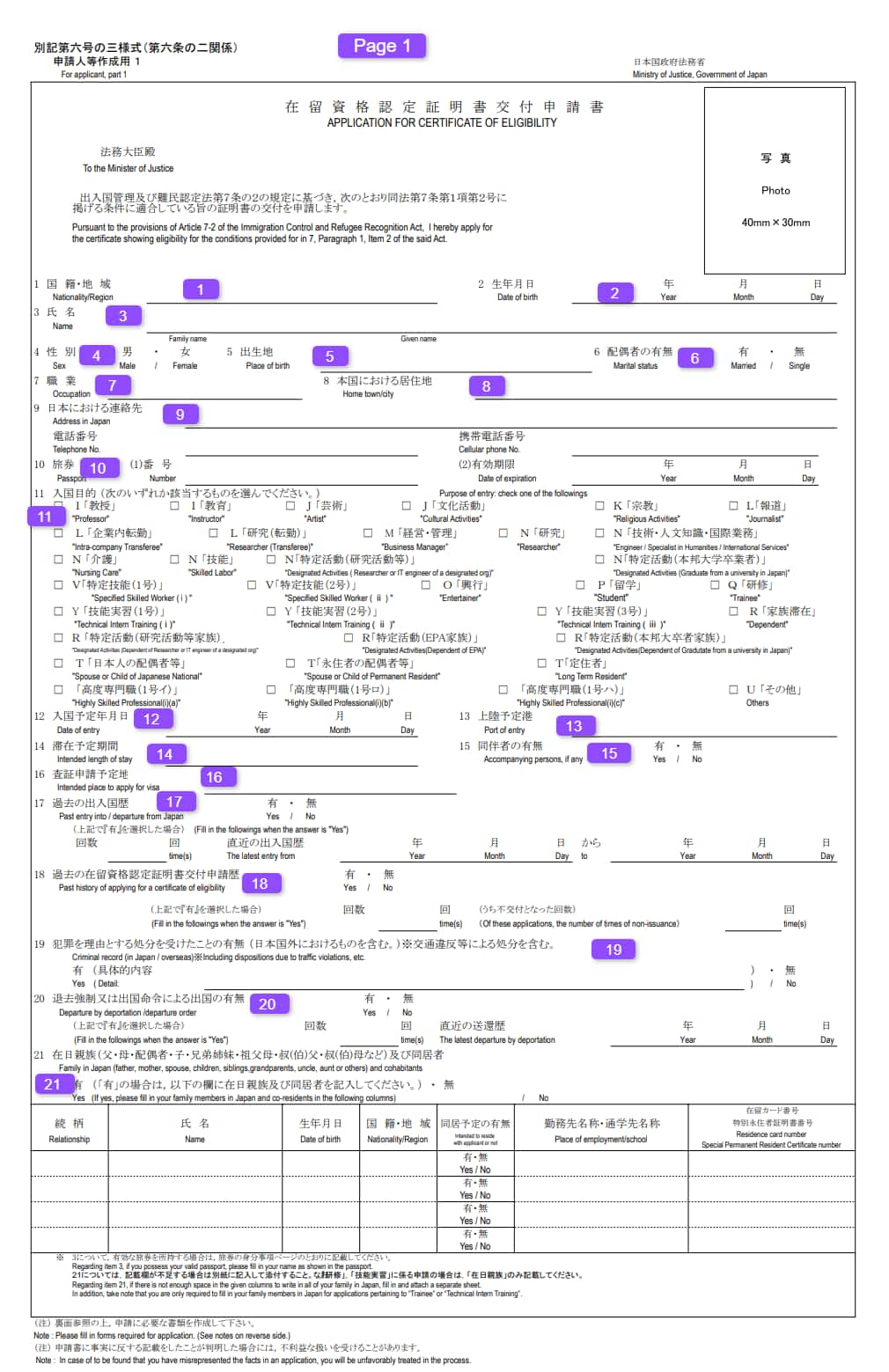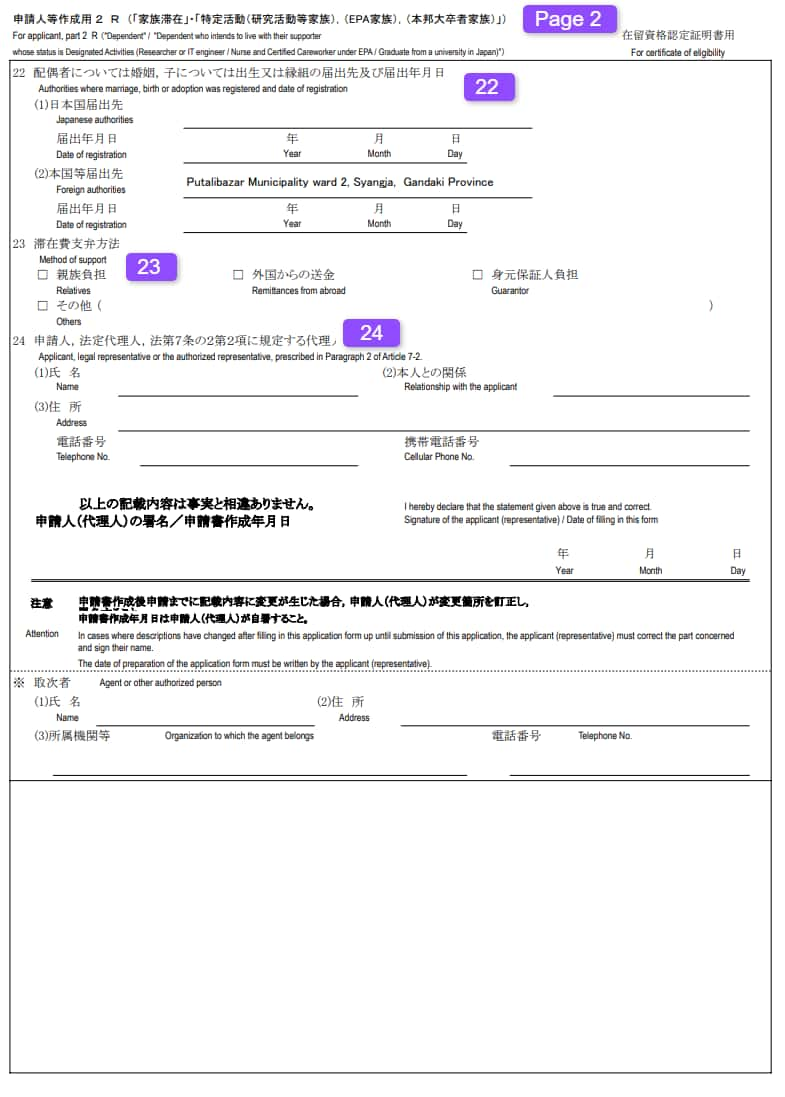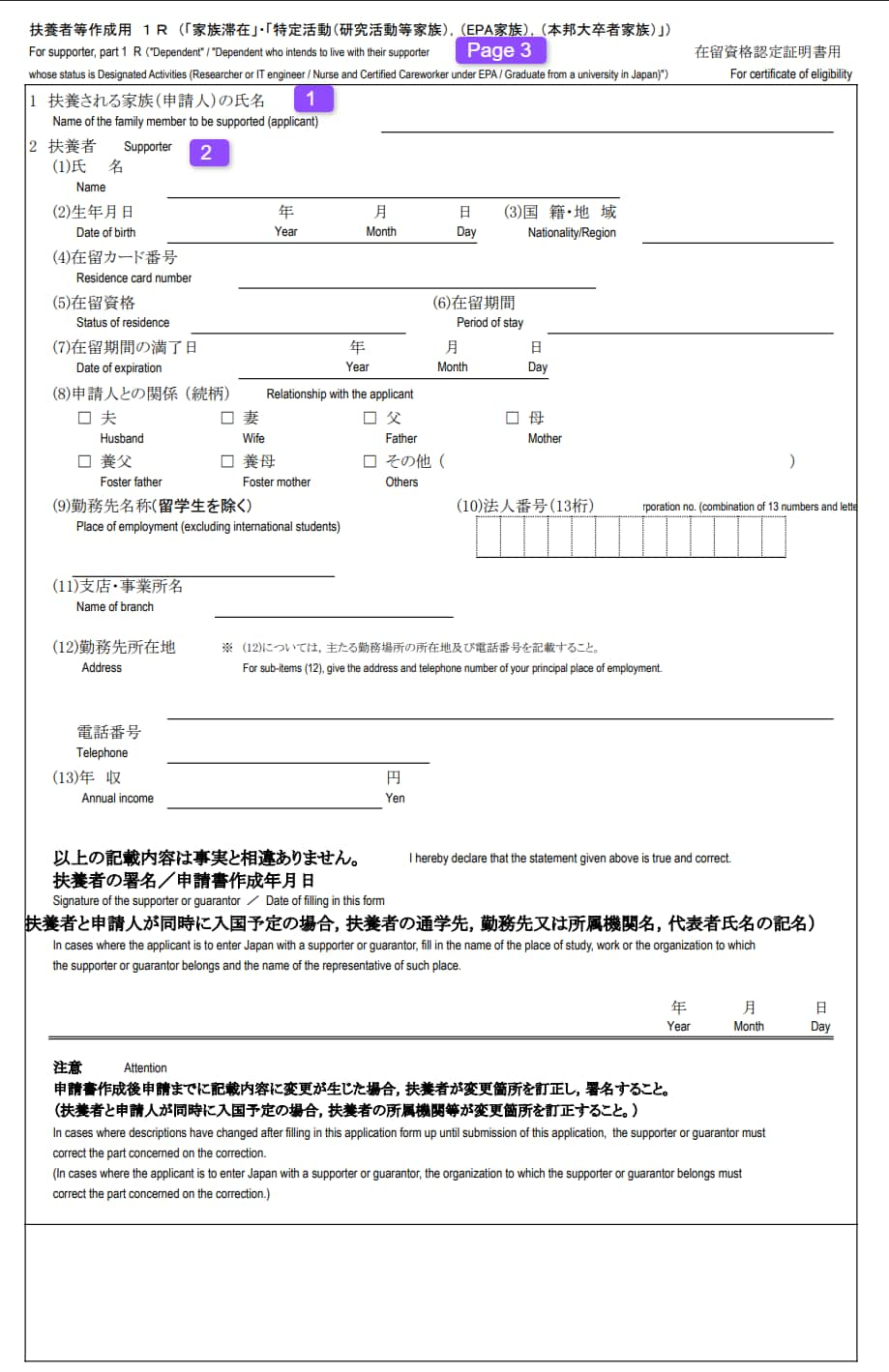Japan Dependent Visa for Spouse: Application Form Filling Guide, Documents Required & Download Links

This guide is inspired by my own experience applying for a dependent visa for my spouse in Japan. When I went through the process, I realized there are many myths, half-truths, and confusing instructions online. So here, I’ll explain clearly what a dependent visa is, why it’s needed, the actual documents you need, and also provide a simple guide to filling the application form with downloadable versions of the form itself.
What is a Dependent Visa in Japan?
A dependent visa allows the spouse and children of a foreign resident in Japan (holding a valid work visa or student visa) to live with them legally in Japan. If you are working full-time, studying, or already residing in Japan under a proper visa, you can invite your spouse to join you by applying for this visa.
For example, if you first entered Japan as a student and later moved to a work visa, you can apply for your spouse’s dependent visa as soon as your status is updated. This visa gives your partner the legal right to live in Japan and, with special permission, they can also take part-time work.
Clearing Common Myths About the Process
There are so many myths about the dependent visa application process, and I came across a lot of them myself when I applied. Let’s clear up the most common ones so you don’t get confused like I did.
- “You must wait 4–5 months after changing from student to work visa before applying” — Not true. Once your status is officially updated and you have proof of employment, you can apply immediately.
- “You need a large bank balance to prove financial stability” — Not required. Immigration focuses more on steady employment and tax records, not your personal savings.
- “You must submit your bank book or salary slips” — Also not required in most cases. Instead, you submit tax certificates and a certificate of employment.
- “Only Japanese citizens can sponsor a dependent” — Incorrect. Foreign residents with valid work or long-term visas can also sponsor their spouse or child.
- “If your salary is low, your dependent visa will be rejected” — Not automatically true. Immigration looks at your overall stability (contract type, tax payments, and proof you can support dependents), not just a single salary figure.
- “If you apply through a lawyer, it will be faster” — Not true. Processing times are the same whether you apply by yourself or through a lawyer. What a lawyer does help with is making sure your application is accurate and complete, which may prevent delays caused by missing documents.
- “You must use an immigration lawyer or agent” — Optional. Many people successfully apply on their own if they prepare documents carefully. An agent can help if your case is complicated, but it’s not mandatory.
- “It’s faster if you apply from abroad” — Not necessarily. Processing speed depends on the immigration office workload and the completeness of your documents, not whether you apply from Japan or overseas.
Required Documents for Dependent Visa Application
These are the documents I prepared and submitted when applying for my wife’s dependent visa. Each document has a specific purpose, and I’ll explain briefly what it is and how to get it:
- ✅ Application form — The official dependent visa application form. This is the main document you fill out and submit (see download section below).
- ✅ 在職証明書 (Zaishoku shōmei-sho) — Certificate of Employment. This is issued by your company’s HR or general affairs department and proves that you are currently employed in Japan. It usually shows your job title, start date, and company details.
- ✅ Marriage certificate — Proof of marriage issued by your home country or Japan (depending on where you married). If it’s not in Japanese, you must attach a Japanese translation. This shows the legal relationship between you and your spouse.
- ✅ 納税証明書 (Nōzei shōmei-sho) — Tax Certificate. Issued by your local city hall or ward office. It confirms that you have properly paid taxes in Japan. Immigration uses it to check your financial responsibility.
- ✅ 課税証明書 (Kazei shōmei-sho) — Taxation Certificate. Also issued by your city hall or ward office. It shows your annual income and how much tax was levied on you. This helps immigration confirm your ability to support your spouse financially.
- ✅ 住民票 (Jūminhyō) — Resident Record. This document lists your current address and household information. It’s not always mandatory for this application, but including it makes your application stronger and avoids requests for additional documents later.
- ✅ Residence card photocopy — A copy of the sponsor’s residence card (front and back). This proves your legal status in Japan and the type of visa you currently hold.
- ✅ Passport photocopies — Copies of both your passport and your spouse’s passport. Usually the identification page and visa/stamp pages are required to confirm personal details and entry/exit history.
Download the Application Form
The official dependent visa application form can be filled either by hand or on computer (Excel version). Below you can download both formats directly:
How to Fill the Dependent Visa Application Form
When you download the form, you will notice that it contains multiple pages. However, for the application process, you are only required to fill in and submit three main pages. In the sections below, we explain each of these pages — Page 1, Page 2, and Page 3 — with step-by-step guidance and examples on how to complete them correctly.
Page 1: 個人情報 / Personal Information
This section is where you enter the dependent’s personal information — the person you are applying for. For example, if you are the husband applying for your wife, fill in your wife’s details exactly as they appear on her passport (name, passport number, birthdate, etc.). Do not put your own information here.

1. 国籍・地域 (Nationality / Region)
In this box, write the nationality of your spouse exactly as it appears in their passport.
For example, if you are the husband applying for your wife, you should write your wife’s nationality — not your own.
Example: India / Philippines / Nepal
Example (Japanese Katakana - if you want to write in japanese): インド / フィリピン / ネパール
2. 生年月日 (Date of Birth)
Write your spouse’s date of birth in the format YYYY/MM/DD (Year / Month / Day).
For example, if your wife was born on July 15, 1995, you would write:
Example: 1995/07/15
3. 氏名 (Name)
Here you need to write your spouse’s full name exactly as it appears in her passport.
Always put the family name first, followed by the given name.
For example, if you are applying for your wife, you would write your wife’s name as it is in her passport.
Example: MILLER Emma
4. 性別 (Sex)
Select the correct option for your spouse’s sex by ticking either 男 (Male) or 女 (Female). For example, if you are applying for your wife, you would tick 女 (Female).
5. 出生地 (Place of Birth)
Write the city and country of your spouse’s birth exactly as shown in her passport.
For example, if you are applying for your wife, you might write your wife birth place:
Example: Berlin, Germany
6. 配偶者の有無 (Marital Status)
Choose the correct marital status for your spouse by ticking either 有 (Married) or 無 (Single). if you are applying for your wife’s dependent visa, you should select 有 (Married).
7. 職業 (Occupation)
Write your spouse’s current occupation.
If you are applying for your wife and she is not working, you can write “Unemployed” or “Housewife.”
Examples: Teacher / Housewife / Unemployed
8. 本国における居住地 (Home Address in Home Country)
Write your spouse’s permanent home address in her country of residence.
If you are applying for your wife, enter the full address as written in her passport or official documents.
Example: 45 Park Avenue, London, United Kingdom
9. 日本における連絡先 (Address in Japan)
Write the Japanese address where your spouse will live after she arrives.
If you are applying for your wife, this will be your own address in Japan.
Example: 2-3-5 Shinjuku, Tokyo, 〒160-0022
10. 旅券 (Passport)
Here you need to enter your spouse’s passport details.
If you are applying for your wife, copy the information exactly as it appears in her passport:
・番号 (Passport Number) → Example: TK1272567
・有効期限 (Expiry Date) → Example: 2029/03/15
11. 入国目的 (Purpose of Entry)
This section is about the reason for your spouse’s stay in Japan. For example, if you are applying for your wife’s visa, the purpose should be 家族滞在 (Dependent), so you can select that option here.
12. 入国予定年月日 (Intended Date of Entry)
Here, write the date when the person you are applying for will enter Japan. It does not need to be the exact date — just an estimated or expected date is fine. If you already know the exact date, you can write it, but it is not required. This date is only to give immigration an idea of when your spouse might come to Japan, so it is not necessary for them to arrive exactly on that day.
Example: 2025/04/01
13. 上陸予定港 (Port of Entry)
Write the airport where your spouse is expected to arrive in Japan. For example, if the flight lands in Tokyo you can write Narita or Haneda, and if it lands in Osaka you can write Kansai. It does not have to be exact — just the most likely airport of arrival.
Example: Narita / Kansai
14. 滞在予定期間 (Intended Length of Stay)
Write the same period as the length of your own visa (for example, 1 year, 3 years, or 5 years). This is only your request — the final decision about how long your spouse’s visa will be is made by immigration.
Example: 3 years
15. 同伴者の有無 (Accompanying Persons)
This asks whether someone will come to Japan together with your spouse. If you are only applying for your spouse, choose 無 (No). If you are applying for more than one person at the same time (for example, your spouse and children), then choose 有 (Yes) and write their details in the space provided.
Example: No (if only spouse) / Yes (if spouse + children)
16. 査証申請予定地 (Place to Apply for Visa)
This is the Japanese Embassy or Consulate where your spouse will apply for their visa after you send them the Certificate of Eligibility (COE). Usually, it will be the embassy/consulate in their home country or the one nearest to where they live.
Example: Embassy of Japan in Manila
17. 過去の出入国歴 (Past Entry/Exit History)
If spouse has visited Japan before, tick 有 (Yes) and list. If never, tick 無 (No).
18. 過去の在留資格認定証明書申請歴 (Past COE Applications)
If spouse applied before, tick 有 (Yes) and note how many times. If not, tick 無 (No).
19. 犯罪歴 (Criminal Record)
Select 無 (No) if your spouse has no criminal record. If there is a record, select 有 (Yes) and provide the details honestly. Even traffic violations may sometimes be considered.
20. 退去強制歴 (Deportation / Departure Order)
If your spouse has ever been deported from Japan or received a departure order, select 有 (Yes) and provide details. If not, select 無 (No).
21. 在日親族及び同居者 (Family in Japan & Co-residents)
In this section, you need to list the relatives who are already living in Japan.
For example, if a husband is living in Japan and applying for a dependent visa for his wife, he should select “Yes” and enter his own details as the sponsor.
If there are more relatives in Japan, their information can also be added in the following rows.
If there are no relatives in Japan, then “No” should be selected.
In the sample image below, only the husband’s details are written as an example of how to fill in the sponsor’s information.

Page 2: 出生・資金・代理人 / Birth, Financial Support, and Representative
This page asks for extra background details related to your spouse. Here you will fill in information such as where the birth or marriage was registered, how your spouse’s living expenses in Japan will be covered, and whether any representative or agent is involved in the application process. These sections confirm the basic family records, financial support plan, and the person responsible for submitting or preparing the application.

22. 婚姻・出生・縁組の届出先 (Marriage / Birth / Adoption Registration)
This section applies mainly for spouse or child dependent visa applications. Here you need to write where and when the marriage, birth, or adoption was officially registered.
- (1) 日本国届出先 (Japanese Authorities): If the marriage or child’s birth was registered in Japan, write the city hall name and the date of registration.
- (2) 本国等届出先 (Foreign Authorities): If it was registered in your home country, write the name of the official authority (for example: local municipality or Ministry of Home Affairs) along with the date of registration.
Example for a foreign marriage:
Foreign Authorities: “Putalibazar Municipality, Ward 2, Syangja, Nepal”
Date of Registration: 2019/05/22
23. 滞在費支弁方法 (Method of Support)
Here you show how your spouse’s living expenses will be covered in Japan. Tick one or more boxes:
- 親族負担 (Relatives): Select if you, the sponsor, will cover all expenses. This is the most common option for a spouse visa.
- 外国からの送金 (Remittances from abroad): Select if money will come from overseas family members.
- 身元保証人負担 (Guarantor): Select if another person in Japan is financially guaranteeing your spouse.
- その他 (Others): Rarely used. Only fill if support is coming from a special arrangement (ex: scholarship).
Example (husband in Japan supporting wife): Tick 「親族負担」 because you, the working spouse, will cover her living expenses.
24. 申請人・代理人情報 (Applicant / Representative Information)
This section is signed and dated by the applicant or their representative. If the applicant is outside Japan, the sponsor fills in this section and signs as the representative.
- 氏名 (Name): Write your full name as the sponsor.
- 本人との関係 (Relationship): 配偶者 (Husband/Wife).
- 住所 (Address): Write your address in Japan.
- 電話番号・携帯電話番号: Write your phone number in Japan (mobile preferred).
取次者 (Agent / Authorized Person)
This is only filled if you are using an immigration lawyer (行政書士) or another official representative. If you are applying by yourself for your spouse, you can leave this section blank.
Page 3: Supporter’s Information (扶養者等作成用)
This page is used to provide the details of the supporter in Japan (the person who will sponsor the dependent). The supporter is usually the spouse, parent, or family member already living and working in Japan. Immigration uses this information to confirm the supporter’s residency status, workplace, and ability to financially support the applicant.
For example, if a husband is working in Japan and applying for his wife’s dependent visa, his information will be entered here as the supporter.

1. 扶養される家族の氏名 (Name of the Applicant / Dependent)
Write the full name of the family member you are applying for (your spouse or child), exactly as in their passport.
Example: Emily Rose Carter
2. 扶養者 (Supporter’s Details)
This section is for your details as the supporter in Japan. Fill in your own information clearly:
- (1) 氏名 (Name): Write your full name in English, same as in your passport.
- (2) 生年月日 (Date of Birth): Write in YYYY/MM/DD format.
- (3) 国籍・地域 (Nationality/Region): Your nationality (e.g., India, Nepal, Philippines).
- (4) 在留カード番号 (Residence Card Number): Copy from your Residence Card.
- (5) 在留資格 (Status of Residence): Write your visa type as shown on your Residence Card.
- (6) 在留期間 (Period of Stay): Write the length of your visa (e.g., 1 year, 3 years, 5 years).
- (7) 在留期間の満了日 (Expiration Date): Write the exact expiry date from your Residence Card.
- (8) 申請人との関係 (Relationship to Applicant): Tick the correct box, usually 夫 (Husband) if applying for your wife.
勤務先情報 (Employer Information)
Immigration wants proof that you have stable employment and income to support your spouse. Fill in your company details:
- (9) 勤務先名称 (Company Name): Write your company’s official name.
Example: ABC Co., Ltd. - (10) 法人番号 (Corporate Number): A 13-digit number given to all Japanese companies. You can find it on your company’s website or ask HR.
Example: 1234567890123 - (11) 支店・事業所名 (Branch/Office Name): If you work in a branch, write the branch name. If not, leave blank.
- (12) 勤務先所在地 (Company Address & Phone): Write your company’s full address and main phone number.
- (13) 年収 (Annual Income): Write your yearly income in yen, before tax. Immigration checks this against your tax certificate.
Example: ¥4,200,000
扶養者の署名・日付 (Supporter’s Signature & Date)
At the bottom, sign your name (same as in passport) and write the date you filled the form (YYYY/MM/DD). This confirms that the information you provided is true and accurate.
Conclusion
Applying for a dependent visa for your spouse in Japan can feel intimidating, but the process is simpler than many online rumors suggest.
You don’t need to wait months after switching from a student visa to a work visa, and you don’t need to show bank balances or salary slips.
What matters most are official certificates like employment proof, tax documents, and your marriage certificate.
By preparing the right documents and carefully filling out the form, you can successfully bring your spouse to live with you in Japan.
I hope my personal experience makes the process clearer and helps others avoid the confusion I faced.
Frequently Asked Questions (FAQs)
- 納税証明書 confirms that you’ve paid your taxes.
- 課税証明書 shows your annual income and how much tax was levied.
